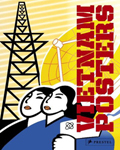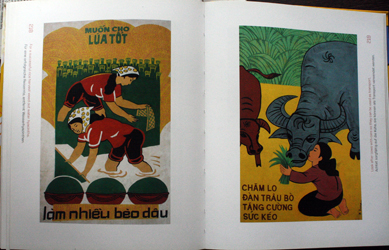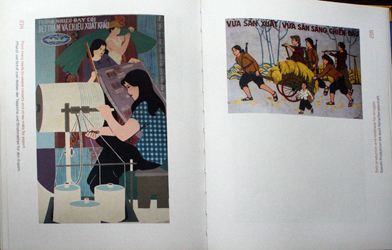звоните: +7 495 204-207-8
e-mail: art@quartagallery.ru
Recent posts
- Необычная судьба тверской художницы Наталии Пономаревой
- Жемчужина деревянной архитектуры русского севера
- Первая народная галерея в Льялово
- Online auction - a practical instruction. How to take part?
- История русской анимации и коллекционирование «истории» мультипликационных фильмов
- История в гравюрах и литографиях уникального печатного издания «Революционная Москва: Третьему конгрессу Коммунистического Интернационала». 1921
- Painting as a Gift
- What happened to frescoes of Kievskaya Metro Station?
Vietnamese propaganda art posters

The posters presented at our website are part of Vietnam propaganda graphic art, which is still alive and flourishes there though in a somewhat “westernized” form. Technically, propaganda production in the territory of Vietnam split into the period before 1975, when it was dedicated mostly to Resistance and wars against two superpowers – France and the USA, and after 1975, glorifying the development of the Socialist Republic of Vietnam.
The earlier examples of propaganda posters, during the Resistance, were printed by hand from engraved woodblocks, the traditional printing technique in Vietnam. Color schemes were restricted to one, two or three tones: black on red, black and red on black and gold and red were popular combinations. In dangerous territories, where guerrilla fighters were on the move to evade the enemy, artists printed small-size posters or leaflets; in safer zones — larger size posters (120 x 80 cm). It was during the Franco- Vietnam War that wall paintings became extremely popular. Artists put their images and slogans directly on the walls of collapsed schools and houses. Resistance artists also devised ingenious ways to create colors in the jungle, mixing quinine and turmeric into day-lily yellow or using mercurochrome for red.
In 1954 the Franco-Vietnam War came to an end. The colonial administration was ended and French Indochina was dissolved under the Geneva Accords. Democratic Republic of Vietnam started its development, and it was in that period that the propaganda art reached its peak. Social realism was formally introduced in Vietnam as the Viet Mihn’s “art for the people” after the Soviet Union and the People’s Republic of China recognized Ho Chi Mihn. A special Propaganda Posters Bureau was created under the Department of Information and Propaganda to coordinate the content, design and printing of posters. The newly introduced technology of offset printing made it possible to increase the production. However, alongside the new fashionable technology old ones, such as lithography, silk and stencil printing, were still in use.
Cultural life in Hanoi was modelled after the Soviet Union. Artists were employed by the state to work as illustrators for the government-controlled press, and as poster-designers for the government’s “advertising” campaigns. On average they were paid 45 dong per month and given 13,5 kilos of rice and half a kilo of meat, plus free drawing supplies and free accommodation. Professors from the Soviet Union taught at the College of Fine Arts that had re-opened in Hanoi, and art students were regularly sent on exchange programs to Soviet universities in Moscow, Leningrad and Kiev.
Having substantial human resources print shops in Vietnam made efficient use of them: several artists usually copied the original by hand putting it on rice paper many times. That is why so many original posters can still be found in Vietnam, each of which is an artwork and despite the perfect technical skill of its creators they sometimes slightly differ in color or tone.
As a rule, propaganda art is divided into “negative” and “positive” campaigns. Positive ones promoted the reconstruction of the country, industrial and agricultural success, also presenting ethnic minorities in colorful traditional dress as part of the socialist trio fighting against the French.
Artists experimented with 1920s Soviet constructivism and photomontage. Vietnamese socialist iconography used to be quite dramatic: for example, a gun engulfed in flames defending a sickle and rice sheaves. However, the authorities also encouraged the revival of folk art and promotion of indigenous artistic roots instead of bourgeois “art for art’s sake”. With a view to that artists were sent on mandatory month-away programs to live and learn from the people, to work in coal mines and paddy fields.

Official posters still appear everywhere in Vietnam, along with socialist symbolism. Despite the rapid change and introduction of video and installation technology into graphic art, socialist retro style is still widely fashionable among contemporary artists.
The posters presented at our website go back to the 1970s, the period marked by the fast industrial growth of the country. All artworks are original, handmade in tempera on rice paper on the basis of stencil printing. Some artworks, such as “Plant many reeds to weave carpets and straw mats for export”, and “For a successful rice harvest weed out water hyacinths” can be found in the unique collection published by PRESTEL, compiled by the collector of Asian art and author David Heather, with the introduction by Sherry Buchanan, a former Wall Street Journal columnist, and specialist in Asian graphic arts.
http://www.quartagallery.ru/posters/istoricheskie/
The article is based on the introduction to the “Vietnam Posters” collection by Sherry Buchanan

